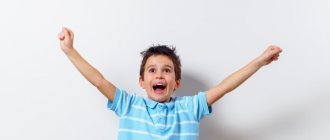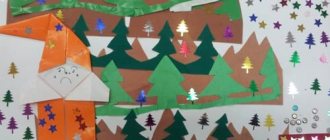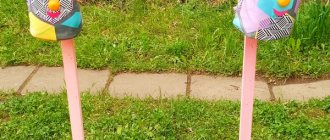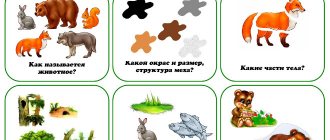Using kinetic sand in working with preschoolers
Using kinetic sand to form elementary mathematical concepts in preschool children
Goal: increasing the level of knowledge of teachers in the formation of elementary mathematical concepts using kinetic sand. Equipment and material: containers with kinetic sand;
counting sticks, multi-colored geometric shapes, a set of numbers, beads, small toys - animals, a set of miniature figures. Progress of the master class:
Good afternoon, dear colleagues!
I would like to begin our meeting and communication with you with the words of the famous psychologist L.A. Wenger “The further path of mathematical development and the success of a child’s advancement in this area of knowledge largely depend on how elementary mathematical concepts are laid down.” Mathematics is a powerful factor in the intellectual development of a child, the formation of his cognitive and creative abilities. It is mathematics that sharpens a child’s mind, develops flexibility of thinking, teaches logic, forms memory, attention, imagination, and speech. The federal state educational standard for preschool education intends to make the process of mastering elementary mathematical concepts attractive, unobtrusive, joyful and entertaining. It is better to master mathematical concepts in a natural, most attractive form of activity for a preschooler - in a game. And as K.D. wrote Ushinsky: “The best toy for children is a pile of sand!” That is why we can use the sandbox in developmental and educational activities, including FEMP. Currently, “kinetic sand” , a new generation of sand, is widely used in working with preschoolers. This innovative material was invented in Sweden in 2013, and quickly gained some popularity. Kinetic sand consists of 98% ordinary pure sand and equally crushed quartz crystals. The remaining 2% of the mixture is a viscous substance that does not allow the sand to dry out and constantly maintains it in a “working” condition. Kinetic sand is 100% non-toxic and safe for children with allergies (does not contain gluten and casein).
Kinetic sand can be of both coarse and finer fractions, but in general it is like sand in a sandbox, the only difference is that it is cleaned and sorted by fraction. The color of the sand is also natural, but there are also multi-colored ones. Kinetic sand does not lose its properties
: if you wet it, nothing will happen, after drying it will become the same again;
it can be washed if necessary. It is convenient to store sand in plastic containers with a lid so that the mixture does not collect dust. To form elementary mathematical concepts in preschoolers, special games and exercises with sand that have mathematical content are carried out during work practice. Such games form children's ideas about size and shape, allow them to teach the child to count, solve problems, compare, navigate in space, develop logical thinking, and form a holistic perception of an object. And the inclusion of small toys, natural and waste materials (pebbles, shells, chestnuts, etc.) in games with sand expands the possibilities of children’s mathematical development, which allows them to master both three-dimensional and two-dimensional space. Games with sand can be used both in joint activities of students with teachers, and independently, because kinetic sand can captivate both adults and children with play for quite a long time, as we will now see, dear colleagues. Let’s just play, like children do, What is “outside the game” is tinsel for them, This is the sweetest thing in the world - Our common game!
Well, it's time to take a closer look at the sand.
Where does any acquaintance begin? Of course, with a greeting. How? Yes, we just touch the sand in different ways. Exercise “Sensitive palms or “Hello sand” Place your hands on a flat surface of sand, leave handprints first on the inside, then on the outside of the hand. Dip your toes in the sand. How did you feel when “communicating” with sand? Did you enjoy it? (participant responses). Communicating with sand is a kind of meditative process that allows you to relax. Similar exercises are used at the beginning of sand work (or classes). This develops fine motor skills of the hands, and, consequently, activates mental activity. Thus, we felt the sand, got to know it, and got ready for further work. Preschool age is a period of intensive development of spatial concepts. With the help of adults, the child learns the simplest ideas about this: left, right, above, below, in the center, above, below, between, etc. All these concepts contribute to the development of spatial imagination in pupils. Exercise to develop spatial concepts Dear participants, take geometric shapes and arrange them according to the instructions: put the blue triangle in the upper right corner, the orange circle in the lower left corner, the yellow square in the lower right, the lilac rectangle in the upper left, the polygon between the blue triangle and orange circle. It is especially worth emphasizing the need to form spatial concepts to prepare preschoolers for school. Orientation in space, which is a sheet of notebook, the ability to see the location of signs on a sheet of paper are specific requirements for a first-grader in the process of learning activities. Without the ability to navigate the surrounding space, without understanding spatial directions, relationships and distances, it is impossible for children to master the first grade curriculum. The insufficient level of their development is revealed in the lessons of writing, reading, mathematics, labor and drawing. Therefore, now we offer you a graphic dictation , but instead of a pencil and a sheet of paper, we will use sand and the developmental mathematical manual “Cuisenaire's Sticks”. Mark the beginning of the path - from the pebble, and then follow the leader’s instructions: TWO sticks - to the left, TWO sticks - down. TWO sticks - to the right, TWO sticks - down, TWO sticks - to the left. What happened? Number 5! It has been noticed that it is easiest for a child to learn numbers, and especially how they look externally, when he makes them with his own hands more than once. You can, of course, sculpt, draw, make appliques, but all this takes quite a long time, but creating masterpieces from sand will not take much time, so you can repeat the game many times. It is necessary to show how to construct a number and invite children to repeat. What about interest? As an option, you can offer to revive fairy tales and bring your own ideas into them! We begin to tell any fairy tale, and from time to time we ask the question “How much?”, which will change the plot. The answer needs to be sculpted out of sand in the form of a number. Example: once upon a time... how many piglets? Masha got into the house, and they lived there... how many bears? Snow White…. How many gnomes? Little Red Riding Hood walked through the forest... How many minutes? Fashion, dear colleagues, any of the numbers mentioned. As you can see, some questions are simply complementary, while others completely change the plot. By playing this way, the child will not only remember the numbers completely naturally, but will also further develop his imagination and learn to compose, and better understand the plots of his favorite fairy tales. The game “Cleaning Numbers” will help you master numbers within the 1st ten ; lay out numbers from 1 to 9 on the sand.
This game trains counting skills, consolidates knowledge of the sequence of numbers, and develops understanding of verbal instructions.
Are your colleagues ready? Tasks:
— remove the number that comes after the number 7;
- remove the number that shows 1 less than 6; - remove the number that shows 4 more than the number 5; — remove the number that comes before the number 4; — remove the number that is greater than 6 but less than 8; Name the numbers that are left in the sand. Thank you. One of the initial mathematical concepts that a preschooler needs to master is dividing a whole into parts. This skill allows you to correctly perceive and establish the relationship between an object and its part. Preschool children encounter the need for division very early - in everyday life and play. For example, who among us has not shared an orange, tangerine, apple, etc. But pedagogical experience suggests that without targeted training in dividing a whole into parts, preschoolers will not develop the concepts of “whole” and “part.” The game “Divide the Pie” introduces preschoolers to the concept of “whole” and “part.” Dear colleagues, bake a pie from kinetic sand. (While the participants are making a pie) Dividing a whole into parts is an important area in preparing preschoolers for computing activities, the ability to understand the meaning of problems and in solving them. For the first such lessons, under no circumstances should you use scissors. The child will perceive the cut-off parts as separate whole objects. That is why the study of dividing a whole into parts must begin with the help of the whole subject. For example, you can use a sheet of paper that is divided into parts by folding. Exercise. Find half of the pie, 1/4, 1/8, etc. To do this, using a stack, participants divide the pie in half, and then each half in half again. What can you call each part? (One fourth, one eighth). What's more: a whole pie or one-fourth of a pie? Which is less: one-fourth of the pie or one-second of the pie? What's more: one-half of the pie or one-fourth of the pie? Which is less: one-fourth of the pie or one-half of the pie? Children are able to create interesting structures in the sand and come up with amazing game scenarios. All this is an excellent incentive for the development of imagination and fantasy. By creating a plot and turning it into reality, preschool children learn to act purposefully and achieve results. So, for example, in order for children to receive tactile pleasure and learn to translate tactile sensations into signs, you can use the game exercise “Sand Telegraph” Move.
Participants line up in a column behind each other's heads.
The host of the game “draws” a geometric figure on the back of the last participant with his finger - a straight line, angle, circle, rectangle, triangle, etc. The one who received the “message” must pass it on to the next player in exactly the same way - draw the figure with his finger on the back neighbor The last recipient of the message reproduces the shape with a stick in the sand. After that, he stands at the end of the column, and the game repeats. Once children have mastered “reading” and “telegraphing” information about figures, they can move on to drawing numbers. Dear participants, we have prepared “Wonderful bags” , and in them... let's see what lies there? Participants one by one put their hand into the bag, take out one geometric figure and answer the questions: - What kind of geometric figure is in your hand? Think about what you can add to your figure and draw this image in the sand. Didactic exercise “Complete the figure.” Knowledge of geometric shapes, their properties and relationships broadens children’s horizons, allows them to more accurately and comprehensively perceive the shape of surrounding objects, which has a positive effect on their productive activities (for example, drawing, modeling). The game exercise “Multi-colored paths” will help to consolidate knowledge about geometric shapes . You and I will make paths from top to bottom from geometric shapes so that there are no two figures of the same shape and color next to each other. Use only yellow, orange and green colors. In the process of mathematical and general development of preschool children, a significant place is occupied by teaching them to solve and compose simple arithmetic problems. In kindergarten, preparatory work is carried out to develop children's confident calculation skills when adding and subtracting single-digit numbers in order to prepare them for learning in primary school. The game exercise “Multi-colored mosaic” is an excellent assistant in solving simple examples and problems involving addition and subtraction. 1. The first snowdrop appeared in the spring, joyfully nodded its head to the sun. Following him, six more blossomed, like a bouquet, welcoming the spring days. How many flowers are there in total? 1+6=7 (Replace the pebbles with numbers) 2. I brought a willow twig home, The bud on it had already opened. She put a willow in the water, and eight of them opened - the willow was blooming. How many buds opened on the branch at night? 8-1=7 We offered as an example the simplest problems, the solution of which will help children understand the meaning of arithmetic operations - addition and subtraction. By the time they enter school, children should have a whole range of mathematical knowledge. The child needs to have an idea of set, number, shape, size; be able to navigate in time and space, and one of the assistants, as you have seen, is kinetic sand. In conclusion, I would like to note that mathematics has a unique developmental effect. “Mathematics is the queen of all sciences! She puts her mind in order!” And in order to summarize our work, we invite you to leave your opinion about our master class on the sand. What do you need to play in the sand?
But, in essence, so little is needed: Love, desire, kindness, So that Faith in Childhood does not disappear. A set of small toys, Let's take it to the game... Like God, We will create our own World of Wonders, Having walked the Road of Knowledge. Dear teachers, thank you for your work and wish you creative success! Discover the world with your child! Together is always better than just next to each other!
We recommend watching:
Mathematical games with Cuisenaire sticks for children 6-7 years old Mathematical games with geometric figures for children 5-7 years old Mathematical fairy tale - a game for children of the preparatory group of preschool educational institutions Didactic games in mathematics for children 4-6 years old
Similar articles:
Exercises with counting sticks for preschoolers
Math problems jokes for preschoolers
Mathematical riddles for preschoolers in verse with answers
Games for the development of elementary mathematical concepts in preschoolers 3-5 years old
Games with geometric shapes for children 4-6 years old
Correctional work is great work for a child. The Federal State Educational Standard for Preschool Education indicates the need to “create favorable conditions for the development of children in accordance with their age and individual characteristics” and aims at ensuring that the child can freely “use speech to express his thoughts, feelings and desires...”.
To achieve this target in preschoolers with speech disorders, it is necessary to maintain interest in classes, relieve emotional and muscular tension that arises during correctional work, find new effective means, thereby reducing the time required for the stages of correctional intervention and directing efforts to activate independent speech. Therefore, for the successful correction of speech and motor skills in children, I decided to use sand in my work.
Sand therapy is one of the types of play therapy. And as you know, the main activity of a preschooler is play. In it he gets to know himself and the world around him. Playing in the sand is one of the natural activities of a child.
Kinetic sand is an innovative material for creativity and games, educational and cognitive processes.
Transferring traditional pedagogical classes to the sandbox gives a greater educational effect than standard forms of training.
Speech therapists know how long and monotonous the process of automating sounds can be; using sand to work on speech correction turns monotonous classes into an exciting process.
Kinetic sand was created in 2013. The sand consists of 98% pure sand and 2% silicone polymer. At first glance, it resembles wet sea sand, but as soon as you take it in your hands, its unusual properties appear. Polymer materials and quartz provide the viscosity necessary for modeling; it is plastic - on the one hand, and “fluid” on the other. You touch it, the sand “moves”, “comes to life”, flows through your fingers and at the same time remains dry. It is loose, but you can build a variety of shapes from it, it is pleasant to the touch, and does not leave marks on your hands. Can be used as a relaxant.
Kinetic sand can be used on any surface.
Material spilled on the floor does not scatter into separate particles, but is stored in the form of a compact mass that is easy to collect and reuse.
Sand is absolutely harmless, has antibacterial properties, does not contain toxic substances and does not cause allergies, therefore it can be used with the smallest children, both at home and in kindergarten.
Kinetic sand is a fabulous material for working with a child.
To organize games with sand, you need plastic molds of various sizes and themes, dough molds, stacks or wooden spatulas, a large set of miniature objects and toys, which together symbolize the world around us and reflect work on lexical topics. In my work I use figures of characters from Kinder Surprises, Lego, as well as various pebbles, shells, buttons, and large beads.
Using kinetic sand, I solve the following problems:
- development of phonemic concepts;
- improving the grammatical structure of speech;
- automation of delivered sounds;
- literacy training;
- development of coherent speech;
- formation of the syllabic structure of speech;
- development of fine motor skills.
Along with this, it is known that sand absorbs negative mental energy and has a relaxing effect. Experience shows that the use of sand therapy allows even a complex child to open up, maintain a preschooler’s ability to work longer, and also increase interest in speech therapy classes.
Games with kinetic sand used in work:
"Sand figure"
The child draws figures in the sand, then decorates them with various objects: pebbles, shells, buttons, coins. Thus, we fix the names of geometric shapes. Just like figures, you can decorate anything: fingerprints, palm prints, toys, etc.
“Whose traces?”
“Traces of a bear” - the child presses forcefully onto the sand with his fists and palms. “Hare tracks” - the child hits the surface of the sand with his fingertips, moving in different directions (like a hare jumping). “Traces of a snake” - a child makes the surface of the sand wavy with his fingers.
"Guess a riddle".
The child guesses the riddle and looks for the answer-toy in the sand.
“What’s missing?”
The child buries toys in the sand and says what is missing. Thus, we consolidate the use of nouns in the genitive case, singular and plural.
"Game of cars."
A game on the use of prepositions in speech: to, between, for, before, because of. The child talks about the location of the car relative to others. (The red car is driving towards the green car. And the blue car is standing between the trees.)
“Choose your words.”
The child selects adjectives (attribute words) for the toys that he finds in the sand. For example, a fox is cunning, red, etc.
"Count it."
The child counts from 1 to 5 a toy that he finds in the sand. For example, one elephant, two elephants, three elephants, four elephants, five elephants.
We will look for animals and choose words for them. A hedgehog, a fox, a bear again... Try to count them.
By analogy, other speech games are carried out: “One-many”, “Name it affectionately”, “Come up with a riddle”, “Name it in one word”, “The fourth odd one”, etc.
“Who can name more?”
The child selects verbs (action words) and places a shell, a pebble, or a button for each word.
By analogy, other speech games are carried out: “Words-relatives”, “Name the vegetables (fruits)”, etc.
“Steps” - pronounce the syllables assigned by the speech therapist, “walking” them with your finger in the sand.
“Find toys” - the speech therapist buries toys with the sound L in the sand: a horse, a doll, a spoon, an elephant, so that the toy in the sand is indicated by a low mound. Then he invites the child to find toys and name them. Ask what sound is heard in all the words. Ask them to make a sentence with each toy.
"In search of treasure."
This fairy sand comes to our lesson. We love to sculpt, play and get toys.
Children look for pictures and objects in the sand. And they say: “I found a cat...”
"Girlfriends"
Sound differentiation game. Invite children to give gifts (toys, pictures) to two girlfriends: Masha - gifts with the sound [w], and Sonya - gifts with the sound [s]. Dig gifts out of the sand.
Games to differentiate other sounds are played in the same way.
“Hide your hands” - hide your hands in the sand after hearing a given sound.
“Sound pattern” Children lay out sound patterns from colored pebbles (blue, green, red) on the sand and perform sound-letter analysis of words.
“How many syllables?” The speech therapist (then the child) draws a given number of stripes on the sand, indicating syllables, and then comes up with a word based on their number.
With the help of various toys, children compose a fairy tale on the sand, retell it or dramatize it.
“Find the letters and name them.”
The speech therapist hides plastic letters in the sand. The child must find and name all the letters.
“Say the word.”
The child takes out the letter hidden by the speech therapist and names a word starting with this sound.
"Make a word."
The speech therapist hides plastic letters in the sand. The child must find, name all the letters and make a word from them.
In my work, I noted that the use of kinetic sand gives positive results. Children's interest in speech therapy classes increases significantly. They feel more successful. They want to replay even a failed exercise several times, eventually achieving the desired result.
Any teacher can use kinetic sand in their work when the issue of interacting with children who require special attention arises. This is relevant when organizing inclusive education.



